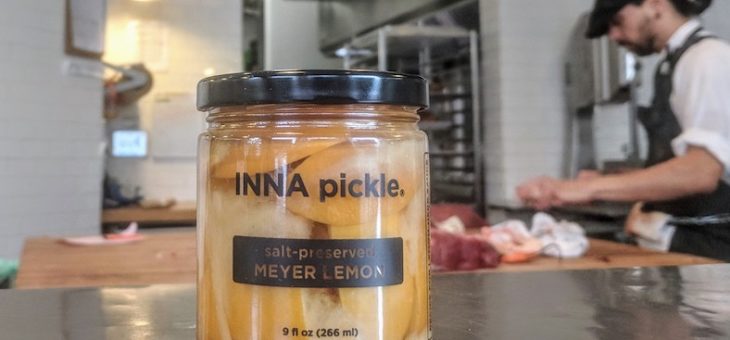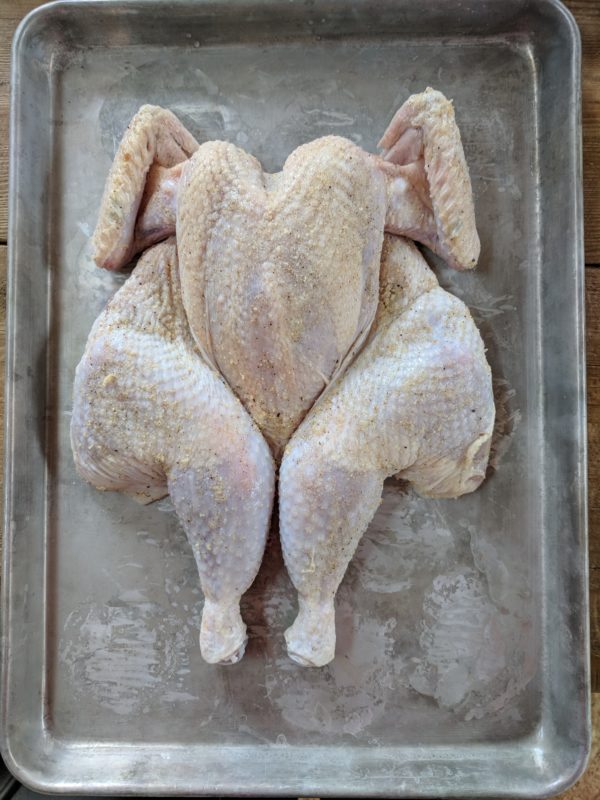
Spatchcock is a butchery term that refers to splitting open poultry or game birds for cooking. The backbone is removed and the carcass is pushed flat. The benefit to spatchcocking a chicken is faster, more even cooking. I also find it much easier to carve for serving. It’s particularly good for grilling and a great option for quicker roasting. Our butchers are happy to spatchcock poultry for you, or you can do it at home yourself in two steps:
- Remove the backbone: Using very sharp kitchen shears, start at one side of the tail and cut all the way along the spine. Repeat on the other side. Save the backbone for stock.
- Press flat: Splay the bird open with the skin side up. Place your palms in the center of the breast (like you’re giving it chest compressions) and press down firmly until you hear the breast bone crack. Your chicken will then lie flat.
This recipe features salt preserved meyer lemons from INNA Jam, which are made right here in the East Bay and stocked at The Local Butcher Shop. If you aren’t familiar with preserved lemons, you are in for a treat. They are pungent and briney, and a little goes a long way. A simple compound butter is made with the preserved lemon to slip under the chicken’s skin before roasting. The butter keeps the breast moist, and the lemon seasons the meat with aromatic citrus. This preparation is particularly good cold and leftover — perfect for a picnic.
Roasted Spatchcocked Chicken with Preserved Lemon
Notes: This recipes outlines an overnight salt cure, which dries out the skin so it browns nicely. You could brine your chicken instead (which does help tenderize the meat), but plan to do it two days before roasting and let it dry out overnight in the refrigerator. If the skin is soggy from the brine, it just won’t brown.
- 1 whole pasture-raised chicken, spatchcocked
- 1/4 cup INNA Jam preserved lemons, finely chopped
- 1/4 cup unsalted butter, softened to room temperature
- salt & pepper
Place the chicken on a rimmed baking sheet or in a roasting pan that can fit in your refrigerator. Salt and pepper both sides of the bird liberally. Position the chicken skin side up and refrigerate overnight.
Remove the bird from the refrigerator an hour before cooking so it can come to room temperature. Brush off any excess salt.
Meanwhile, make the compound butter by mixing the chopped lemons into the butter and adding a few grinds of black pepper.
Preheat the oven to 425°F.
With the legs of the chicken facing toward you, carefully separate the skin from the breast meat. Be gentle, try your best not to tear the skin. Slip a few tablespoons of compound butter under the skin of each breast and work it evenly over the meat. Take any remaining butter and rub it all over the skin of the bird.
Place the chicken in the oven. Every 15 minutes or so, baste the bird with the buttery juice released in the pan. After 40 minutes, use a meat thermometer to check the internal temperature of the bird. Look for the thickest part of the breast to read 160°F when done.
Remove the chicken from the oven and let it rest for 10 minutes before carving.


Leave a Comment